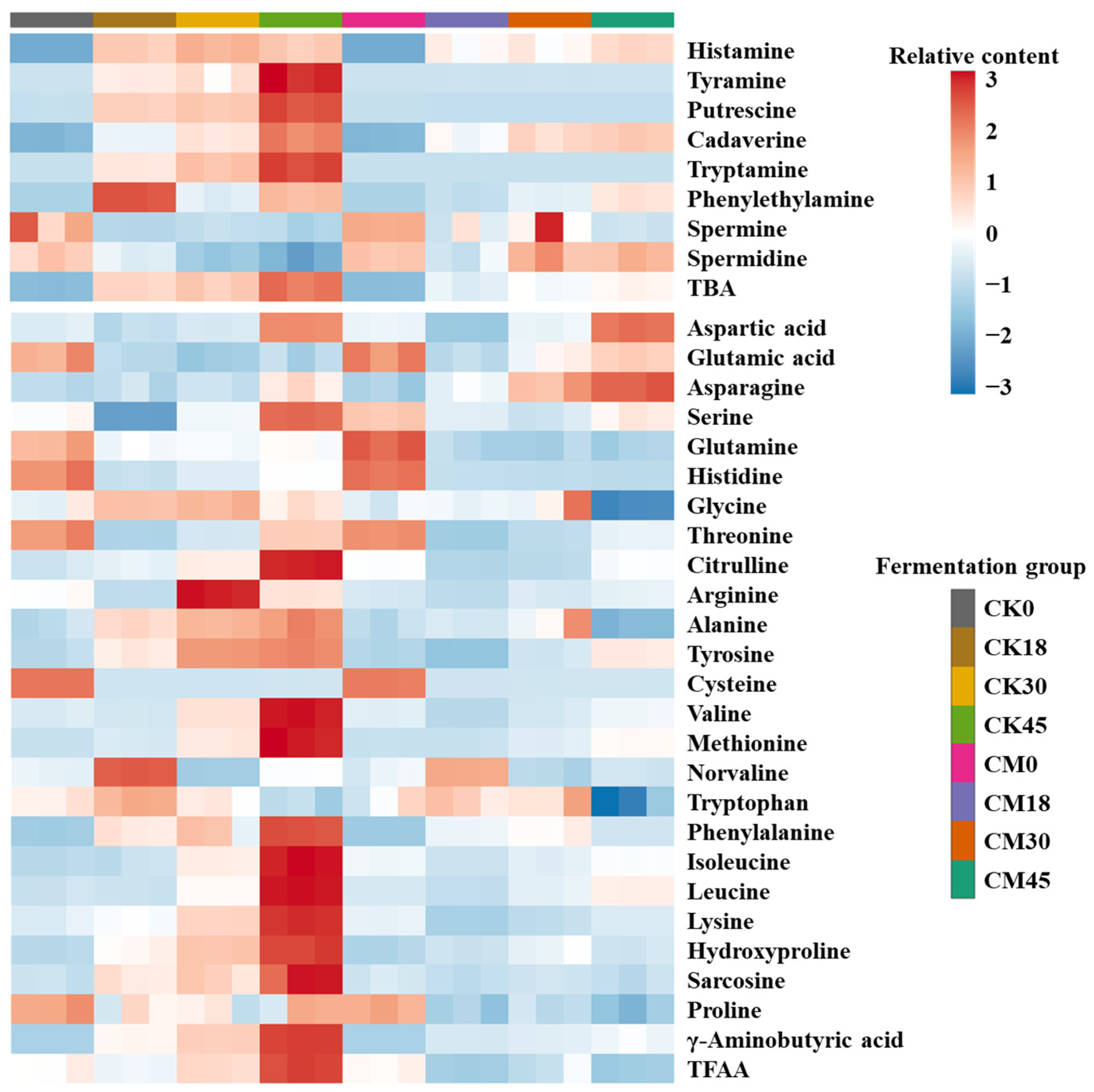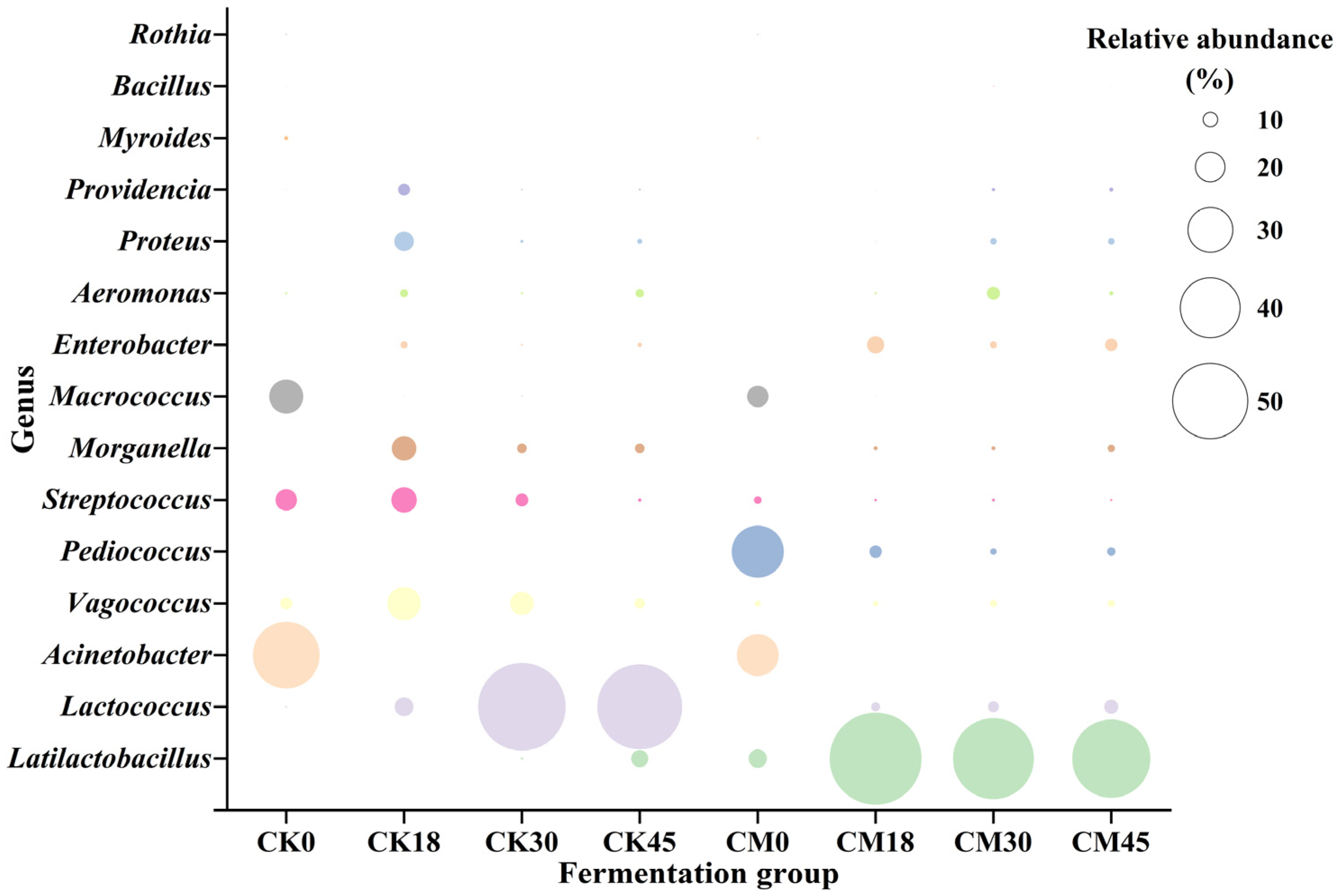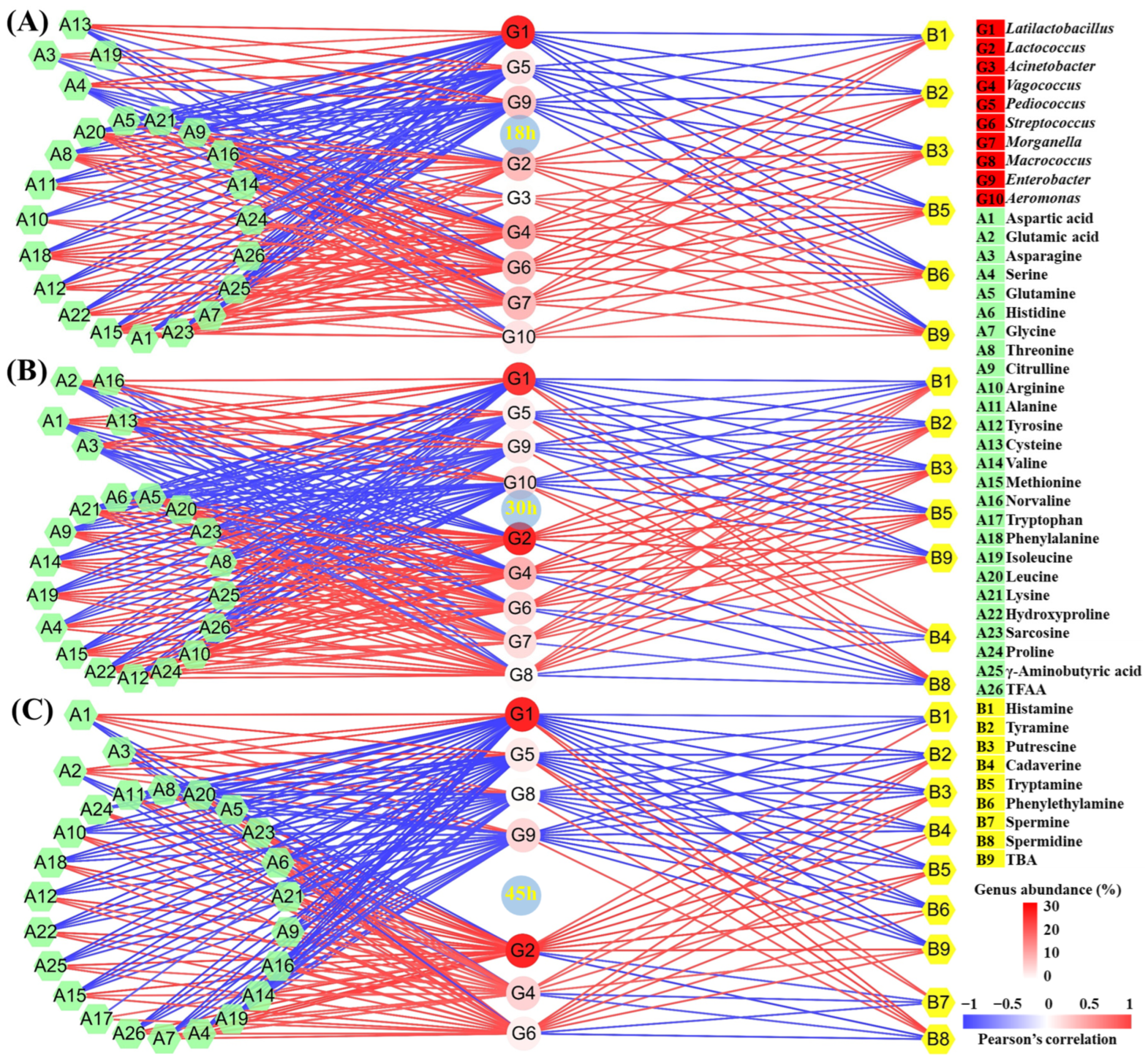Inhibition of Biogenic Amines in Fermented Tilapia Surimi by Collaborative Fermentation of Latilactobacillus sakei and Pediococcus acidilactici
Abstract
1. Introduction
2. Materials and Methods
2.1. Preparation of Starter Strains
2.2. Tilapia Surimi Fermentation
2.3. Detection of BAs
2.4. Detection of FAAs
2.5. Analysis of Microbial Community
2.6. Statistical Analysis
3. Results and Discussion
3.1. Changes in BAs After Collaborative Fermentation
3.2. Changes in FAAs After Collaborative Fermentation
3.3. Changes in Microbial Composition After Collaborative Fermentation
3.4. Correlation of Core Microbial Genus with BAs and FAAs in Group Dimension
4. Conclusions
Supplementary Materials
Author Contributions
Funding
Institutional Review Board Statement
Informed Consent Statement
Data Availability Statement
Conflicts of Interest
References
- Li, W.; Wen, L.; Xiong, S.; Xiao, S.; An, Y. Investigation of the Effect of Chemical Composition of Surimi and Gelling Temperature on the Odor Characteristics of Surimi Products Based on Gas Chromatography-Mass Spectrometry/Olfactometry. Food Chem. 2023, 420, 135977. [Google Scholar] [CrossRef]
- Cui, Q.; Li, L.; Huang, H.; Yang, Y.; Chen, S.; Li, C. Novel Insight into the Formation and Improvement Mechanism of Physical Property in Fermented Tilapia Sausage by Cooperative Fermentation of Newly Isolated Lactic Acid Bacteria Based on Microbial Contribution. Food Res. Int. 2024, 187, 114456. [Google Scholar] [CrossRef]
- Alcântara, L.O.; Martins, M.E.d.O.; Sousa, J.R.; Cerqueira, M.Â.; Silva, A.L.C.; Souza Filho, M.d.S.M.; Souza, B.W.S. Wettability of Edible Coatings on Nile Tilapia Fillets (Oreochromis niloticus). J. Food Eng. 2019, 247, 152–159. [Google Scholar] [CrossRef]
- Jimenez-Ruiz, E.I.; Maeda-Martinez, A.N.; Ocano-Higuera, V.M.; Sumaya-Martinez, M.T.; Sanchez-Herrera, L.M.; Fregoso-Aguirre, I.O.A.; Rincones-Lopez, J.E.; Palomino-Hermosillo, Y.A. Shelf Life of Fresh Fillets from Eviscerated Farmed Tilapia (Oreochromis niloticus) Handled at Different Pre-Filleting Times. J. Food Process Preserv. 2020, 44, e14529. [Google Scholar] [CrossRef]
- Yoon, W.B.; Park, J.W.; Jung, H. Effects of Potato Protein Isolated Using Ethanol on the Gelation and Anti-Proteolytic Properties in Pacific Whiting Surimi. Foods 2022, 11, 3114. [Google Scholar] [CrossRef]
- Hu, Y.; Shao, Y.; Wu, C.; Yuan, C.; Ishimura, G.; Liu, W.; Chen, S. γ-PGA and MTGase Improve the Formation of ε-(γ-Glutamyl) Lysine Cross-Links within Hairtail (Trichiurus haumela) Surimi Protein. Food Chem. 2018, 242, 330–337. [Google Scholar] [CrossRef]
- Wasinnitiwong, N.; Benjakul, S.; Hong, H. Effects of κ-Carrageenan on Gel Quality of Threadfin Bream (Nemipterus spp.) Surimi Containing Salted Duck Egg White Powder. Int. J. Biol. Macromol. 2022, 221, 61–70. [Google Scholar] [CrossRef]
- Zhao, Y.; Wang, Y.; Li, C.; Li, L.; Yang, X.; Wu, Y.; Chen, S.; Zhao, Y. Novel Insight into Physicochemical and Flavor Formation in Naturally Fermented Tilapia Sausage Based on Microbial Metabolic Network. Food Res. Int. 2021, 141, 110122. [Google Scholar] [CrossRef]
- Li, C.; Cui, Q.; Li, L.; Huang, H.; Chen, S.; Zhao, Y.; Wang, Y. Formation and Improvement Mechanism of Physical Property and Volatile Flavor of Fermented Tilapia Surimi by Newly Isolated Lactic Acid Bacteria Based on Two Dimensional Correlation Networks. Food Chem. 2024, 440, 138260. [Google Scholar] [CrossRef]
- Li, C.; Zhao, Y.; Wang, Y.; Li, L.; Huang, J.; Yang, X.; Chen, S.; Zhao, Y. Contribution of Microbial Community to Flavor Formation in Tilapia Sausage during Fermentation with Pediococcus Pentosaceus. LWT 2022, 154, 112628. [Google Scholar] [CrossRef]
- Dabade, D.S.; Jacxsens, L.; Miclotte, L.; Abatih, E.; Devlieghere, F.; De Meulenaer, B. Survey of Multiple Biogenic Amines and Correlation to Microbiological Quality and Free Amino Acids in Foods. Food Control 2021, 120, 107497. [Google Scholar] [CrossRef]
- Turna, N.S.; Chung, R.; Mcintyre, L. A Review of Biogenic Amines in Fermented Foods: Occurrence and Health Effects. Heliyon 2024, 10, e24501. [Google Scholar] [CrossRef]
- Braga, A.P.A.; Vallim, J.H.; Castanha, R.F.; de Castro, V.L.S.S.; Marin-Morales, M.A. Toxicity Assessment of the Biogenic Amines Cadaverine and Putrescine in Aquatic Organisms. Water Air Soil Pollut. 2024, 235, 197. [Google Scholar] [CrossRef]
- Nie, X.; Zhang, Q.; Lin, S. Biogenic Amine Accumulation in Silver Carp Sausage Inoculated with Lactobacillus Plantarum plus Saccharomyces Cerevisiae. Food Chem. 2014, 153, 432–436. [Google Scholar] [CrossRef]
- Ding, T.; Li, Y. Biogenic Amines Are Important Indices for Characterizing the Freshness and Hygienic Quality of Aquatic Products: A Review. LWT 2024, 194, 115793. [Google Scholar] [CrossRef]
- Park, Y.K.; Lee, J.H.; Mah, J.-H. Occurrence and Reduction of Biogenic Amines in Traditional Asian Fermented Soybean Foods: A Review. Food Chem. 2019, 278, 1–9. [Google Scholar] [CrossRef]
- Li, C.; Chen, S.; Huang, H.; Li, J.; Zhao, Y. Improvement Mechanism of Volatile Flavor in Fermented Tilapia Surimi by Cooperative Fermentation of Pediococcus acidilactici and Latilactobacillus sakei: Quantization of Microbial Contribution through Influence of Genus. Food Chem. 2024, 449, 139239. [Google Scholar] [CrossRef]
- Li, Y.; Li, W.; Li, C.; Li, L.; Yang, D.; Wang, Y.; Chen, S.; Wang, D.; Wu, Y. Novel Insight into Flavor and Quality Formation in Naturally Fermented Low-Salt Fish Sauce Based on Microbial Metabolism. Food Res. Int. 2023, 166, 112586. [Google Scholar] [CrossRef]
- Nie, X.; Lin, S.; Zhang, Q. Proteolytic Characterisation in Grass Carp Sausage Inoculated with Lactobacillus Plantarum and Pediococcus Pentosaceus. Food Chem. 2014, 145, 840–844. [Google Scholar] [CrossRef]
- Li, C.; Li, W.; Li, L.; Chen, S.; Wu, Y.; Qi, B. Microbial Community Changes Induced by a Newly Isolated Salt-Tolerant Tetragenococcus Muriaticus Improve the Volatile Flavor Formation in Low-Salt Fish Sauce. Food Res. Int. 2022, 156, 111153. [Google Scholar] [CrossRef]
- Zhao, L.; Liu, Y.; Xu, Q.; Yu, Y.; Zheng, G.; Wang, Y.; Zhang, Q.; Xu, X.; Zhang, N.; Chu, J.; et al. Microbial Community Succession and Its Correlation with Quality Characteristics during Gray Sufu Fermentation. Foods 2023, 12, 2767. [Google Scholar] [CrossRef]
- Flasarova, R.; Pachlova, V.; Bunkova, L.; Mensikova, A.; Georgova, N.; Drab, V.; Bunka, F. Biogenic Amine Production by Lactococcus lactis Subsp cremoris Strains in the Model System of Dutch-Type Cheese. Food Chem. 2016, 194, 68–75. [Google Scholar] [CrossRef]
- Lan, W.; Sun, Y.; Zhang, N.; Xie, J. Effects of ε-Polylysine and Rosemary Extract on Quality Attributes and Microbial Communities in Vacuum-Packaged Large Yellow Croaker (Pseudosciaena crocea) during Ice Storage. Food Sci. Biotechnol. 2021, 30, 465–474. [Google Scholar] [CrossRef]
- Gezginc, Y.; Akyol, I.; Kuley, E.; Ozogul, F. Biogenic Amines Formation in Streptococcus thermophilus Isolated from Home-Made Natural Yogurt. Food Chem. 2013, 138, 655–662. [Google Scholar] [CrossRef]
- Garbowska, M.; Pluta, A.; Berthold-Pluta, A. Proteolytic and ACE-Inhibitory Activities of Dutch-Type Cheese Models Prepared with Different Strains of Lactococcus Lactis. Food Biosci. 2020, 35, 100604. [Google Scholar] [CrossRef]
- Novak, J.; Pavunc, A.L.; Butorac, K.; Banic, M.; Culjak, N.; Rak, H.; Blazevic, M.; Iveljic, A.-M.; Suskovic, J.; Kos, B. Caseinolytic Proteases of Lactobacillus and Lactococcus Strains Isolated from Fermented Dairy Products. Mljekarstvo 2022, 72, 11–21. [Google Scholar] [CrossRef]
- El Mecherfi, K.-E.; Lupi, R.; Cherkaoui, M.; Albuquerque, M.A.C.; Todorov, S.D.; Tranquet, O.; Klingebiel, C.; Rogniaux, H.; Denery-Papini, S.; Onno, B.; et al. Fermentation of Gluten by Lactococcus Lactis LLGKC18 Reduces Its Antigenicity and Allergenicity. Probiot. Antimicrob. Proteins 2022, 14, 779–791. [Google Scholar] [CrossRef]
- Rodriguez-Serrano, G.M.; Garcia-Garibay, M.; Cruz-Guerrero, A.E.; Gomez-Ruiz, L.; Ayala-Nino, A.; Castaneda-Ovando, A.; Gonzalez-Olivares, L.G. Proteolytic System of Streptococcus thermophilus. J. Microbiol. Biotechnol. 2018, 28, 1581–1588. [Google Scholar] [CrossRef]
- Hu, T.; Cui, Y.; Qu, X. Analysis of the Proteolytic System of Streptococcus thermophilus Strains CS5, CS9, CS18 and CS20. Int. Dairy J. 2021, 118, 105025. [Google Scholar] [CrossRef]
- Olvera-Rosales, L.B.; Perez-Escalante, E.; Castaneda-Ovando, A.; Contreras-Lopez, E.; Cruz-Guerrero, A.E.; Regal-Lopez, P.; Cardelle-Cobas, A.; Gonzalez-Olivares, L.G. ACE-Inhibitory Activity of Whey Proteins Fractions Derived of Fermentation by Lacticaseibacillus Rhamnosus GG and Streptococcus thermophilus SY-102. Foods 2023, 12, 2416. [Google Scholar] [CrossRef]
- Hu, Y.; Zhang, L.; Liu, Q.; Wang, Y.; Chen, Q.; Kong, B. The Potential Correlation between Bacterial Diversity and the Characteristic Volatile Flavour of Traditional Dry Sausages from Northeast China. Food Microbiol. 2020, 91, 103505. [Google Scholar] [CrossRef]
- Ba, H.V.; Seo, H.-W.; Seong, P.-N.; Kang, S.-M.; Kim, Y.-S.; Cho, S.-H.; Park, B.-Y.; Ham, J.-S.; Kim, J.-H. Lactobacillus Plantarum (KACC 92189) as a Potential Probiotic Starter Culture for Quality Improvement of Fermented Sausages. Korean J. Food Sci. Anim. Resour. 2018, 38, 189–202. [Google Scholar] [CrossRef]
- Galante, N.; Palavecino Prpich, N.; Campos, C.; Cayré, M.E.; Castro, M. Alternative Culture Medium Design for Biomass Production of Autochthonous Meat Starter Latilactobacillus sakei Sp. Sakei ACU-2. Sci. Rep. 2023, 13, 5205. [Google Scholar] [CrossRef]
- Widenmann, A.W.; Schiffer, C.J.; Ehrmann, M.A.; Vogel, R.F. Impact of Different Sugars and Glycosyltransferases on the Assertiveness of Latilactobacillus sakei in Raw Sausage Fermentations. Int. J. Food Microbiol. 2022, 366, 109575. [Google Scholar] [CrossRef]




Disclaimer/Publisher’s Note: The statements, opinions and data contained in all publications are solely those of the individual author(s) and contributor(s) and not of MDPI and/or the editor(s). MDPI and/or the editor(s) disclaim responsibility for any injury to people or property resulting from any ideas, methods, instructions or products referred to in the content. |
© 2024 by the authors. Licensee MDPI, Basel, Switzerland. This article is an open access article distributed under the terms and conditions of the Creative Commons Attribution (CC BY) license (https://creativecommons.org/licenses/by/4.0/).
Share and Cite
Li, C.; Wang, C.; Deng, J.; Wang, D.; Huang, H.; Zhao, Y.; Chen, S. Inhibition of Biogenic Amines in Fermented Tilapia Surimi by Collaborative Fermentation of Latilactobacillus sakei and Pediococcus acidilactici. Foods 2024, 13, 3297. https://doi.org/10.3390/foods13203297
Li C, Wang C, Deng J, Wang D, Huang H, Zhao Y, Chen S. Inhibition of Biogenic Amines in Fermented Tilapia Surimi by Collaborative Fermentation of Latilactobacillus sakei and Pediococcus acidilactici. Foods. 2024; 13(20):3297. https://doi.org/10.3390/foods13203297
Chicago/Turabian StyleLi, Chunsheng, Chunhui Wang, Jianchao Deng, Di Wang, Hui Huang, Yongqiang Zhao, and Shengjun Chen. 2024. "Inhibition of Biogenic Amines in Fermented Tilapia Surimi by Collaborative Fermentation of Latilactobacillus sakei and Pediococcus acidilactici" Foods 13, no. 20: 3297. https://doi.org/10.3390/foods13203297
APA StyleLi, C., Wang, C., Deng, J., Wang, D., Huang, H., Zhao, Y., & Chen, S. (2024). Inhibition of Biogenic Amines in Fermented Tilapia Surimi by Collaborative Fermentation of Latilactobacillus sakei and Pediococcus acidilactici. Foods, 13(20), 3297. https://doi.org/10.3390/foods13203297










